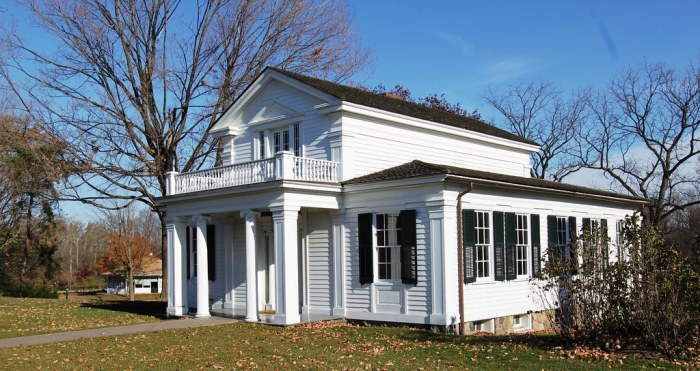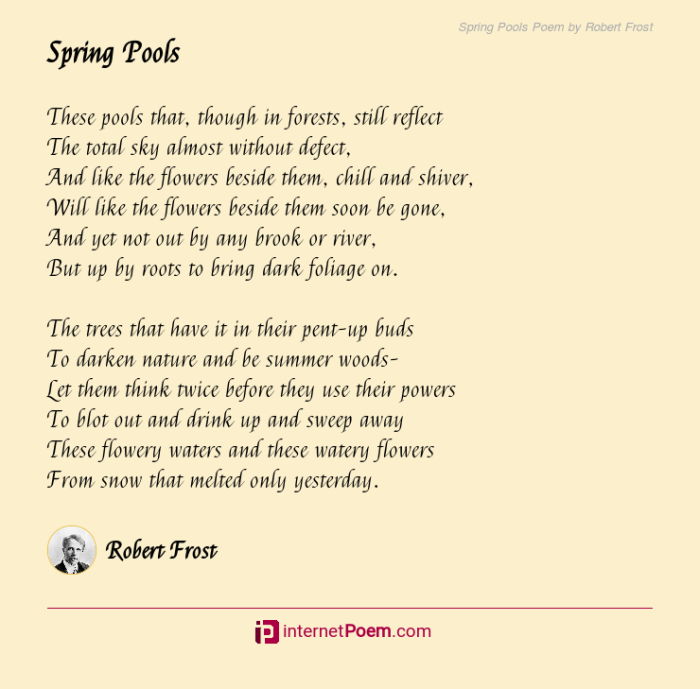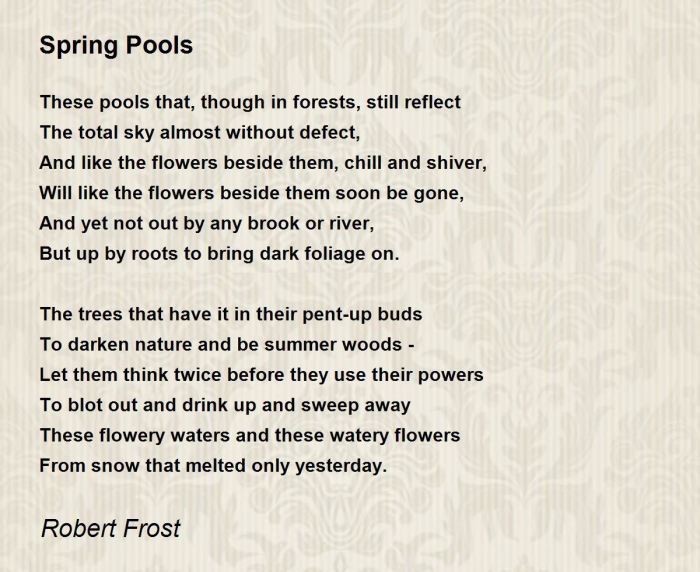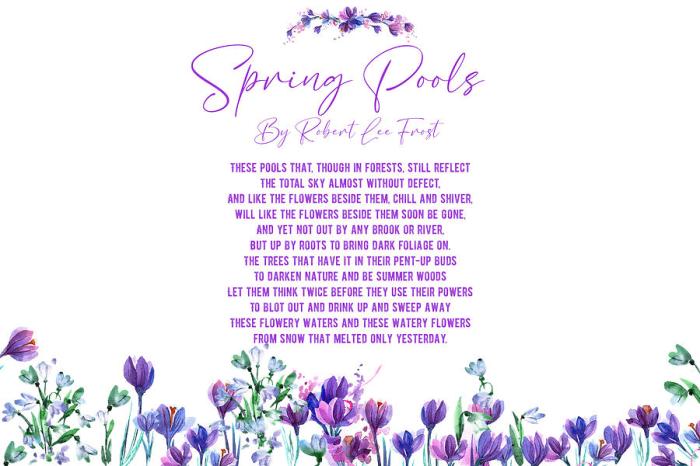Spring pools by robert frost – Prepare to be captivated by Robert Frost’s “Spring Pools,” a poem that paints a vivid tapestry of nature’s beauty and explores profound themes. Join us as we delve into the imagery, tone, structure, and symbolism that make this work a timeless literary gem.
Frost’s exquisite use of language and imagery transports readers to a serene and evocative setting, where spring pools reflect the changing seasons and the complexities of human existence.
Spring Pools
Imagery
Imagery

Robert Frost’s “Spring Pools” is a poem that captures the beauty and tranquility of nature in springtime. The poem’s vivid imagery and sensory details create a setting that is both inviting and evocative.
One of the most striking features of the poem is its use of natural imagery. Frost describes the pools as “deep and clear,” and the water as “glassy.” The trees surrounding the pools are “green and gold,” and the air is filled with the sound of birdsong.
Frost also uses sensory details to create a vivid setting. The reader can almost feel the coolness of the water, the warmth of the sun, and the sound of the birdsong. The poem’s imagery and sensory details combine to create a setting that is both beautiful and inviting.
Symbols
In addition to its vivid imagery, “Spring Pools” also contains several symbols. The pools themselves can be seen as a symbol of life and renewal. The water is clear and clean, and it reflects the sunlight. This suggests that the pools are a place of purity and hope.
The trees surrounding the pools can be seen as a symbol of strength and stability. They are tall and strong, and they provide shade from the sun. This suggests that the trees are a source of protection and support.
The birdsong in the poem can be seen as a symbol of joy and freedom. The birds are singing because they are happy and free. This suggests that the setting of the poem is a place of peace and tranquility.
Spring Pools
Tone and Mood
Tone and Mood

The poem “Spring Pools” by Robert Frost exudes a contemplative and introspective tone. It invites readers to pause and reflect on the ephemeral nature of life and the beauty found in simplicity.The language employed by Frost is both evocative and understated.
The imagery of “glassy” pools and “taut” weeds conveys a sense of stillness and tranquility. The repetition of the word “held” emphasizes the idea of suspension and the fragility of the moment.The overall atmosphere of the poem is one of quiet observation and contemplation.
The reader is drawn into the speaker’s meditative state, inviting them to appreciate the beauty of the natural world and the fleetingness of time.
The murmuring of spring pools by Robert Frost evokes a sense of tranquility and renewal. It reminds us that even amidst the hustle and bustle of life, there are still moments of peace to be found. Like Ahmet, who is allergic to dogs , we may have our own sensitivities and challenges, but we can still appreciate the beauty that surrounds us.
The spring pools, like a balm for the soul, offer a respite from the chaos and remind us to savor the simple pleasures of life.
Spring Pools
Form and Structure
Form and Structure

The poem “Spring Pools” by Robert Frost is a sonnet, a form of poetry consisting of 14 lines written in iambic pentameter. The sonnet is divided into two parts: an octave (the first eight lines) and a sestet (the last six lines).
The octave introduces the poem’s setting and imagery, while the sestet reflects on the meaning of the pools.
Rhyme Scheme
The poem follows a strict rhyme scheme in the octave, with the lines rhyming ABBA ABBA. The sestet has a more varied rhyme scheme, with the lines rhyming CDECDE. This variation in rhyme scheme helps to create a sense of closure and resolution in the sestet.
Meter
The poem is written in iambic pentameter, a meter consisting of five pairs of unstressed and stressed syllables. This meter gives the poem a regular, flowing rhythm that helps to create a sense of movement and energy.
Enjambment and Caesura, Spring pools by robert frost
Frost uses enjambment, the running over of a sentence from one line to the next, throughout the poem. This technique helps to create a sense of continuity and flow, and it also emphasizes the connection between the different images in the poem.
Frost also uses caesura, a pause in the middle of a line, to create emphasis and tension. For example, the line “These pools that, though in forests, still reflect / The total sky almost without defect” contains a caesura after the word “still.”
This pause helps to emphasize the contrast between the pools’ natural setting and their ability to reflect the vastness of the sky.
Spring Pools
Symbolism
Symbolism

Robert Frost’s “Spring Pools” is a poem rich in symbolism, with images that resonate deeply with the reader’s emotions and thoughts. The poem’s central symbol is the spring pool itself, which represents both the beauty and the transience of life.
The spring pool is described as “blue in the spring,” suggesting its connection to new life and renewal. However, the speaker also notes that the pool is “fed by melting snow,” reminding us that even the most beautiful things are ultimately subject to change and decay.
The poem’s other symbols also contribute to its meaning and message. The “young pines” that surround the pool represent the strength and resilience of nature, while the “bluebird” that sings nearby symbolizes hope and joy.
The relationship between the symbols in “Spring Pools” is complex and multifaceted. The spring pool, for example, can be seen as a symbol of both life and death. It is a place of beauty and renewal, but it is also a reminder of the transience of all things.
Ultimately, the symbolism in “Spring Pools” serves to deepen the poem’s meaning and message. The poem is a meditation on the beauty and fragility of life, and the symbols that Frost uses help us to understand the complex relationship between these two opposing forces.
The Spring Pool as a Symbol of Life and Death
The spring pool is the central symbol in “Spring Pools,” and it can be interpreted in a variety of ways. On one level, the pool represents the beauty and joy of life. It is a place of renewal and rebirth, and it is surrounded by the sights and sounds of nature.
However, the spring pool also has a darker side. It is fed by melting snow, which reminds us that even the most beautiful things are ultimately subject to change and decay. The pool is also surrounded by “young pines,” which symbolize the strength and resilience of nature, but which also suggest that the pool is in a state of constant flux.
The spring pool, then, is a complex symbol that represents both the beauty and the fragility of life. It is a place of joy and renewal, but it is also a reminder of the inevitability of death.
The Young Pines as a Symbol of Strength and Resilience
The young pines that surround the spring pool are another important symbol in the poem. The pines represent the strength and resilience of nature, and they suggest that even in the face of change and decay, there is always hope for renewal.
The pines are also evergreen, which means that they remain green throughout the year. This suggests that even in the darkest of times, there is always hope for a brighter future.
The Bluebird as a Symbol of Hope and Joy
The bluebird that sings nearby is another important symbol in the poem. The bluebird is a symbol of hope and joy, and it suggests that even in the midst of sadness and despair, there is always reason to hope.
The bluebird is also a migratory bird, which means that it returns each year after a long winter. This suggests that even after the darkest of times, there is always hope for a brighter future.
Clarifying Questions: Spring Pools By Robert Frost
What is the significance of the spring pools in the poem?
The spring pools symbolize the cyclical nature of life, the constant change and renewal that occurs in both nature and human experience.
How does Frost use imagery to create a vivid setting?
Frost employs vivid descriptions of the natural world, such as the “blue pools” and the “slender trees,” to create a sensory-rich experience that immerses the reader in the poem’s setting.
What is the tone of the poem?
The tone of the poem is contemplative and reflective, with a hint of melancholy. Frost explores the complexities of life and nature, inviting readers to ponder the deeper meanings behind the everyday.
